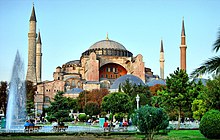Atike Sultan (daughter of Ahmed I)
| Atike Sultan | |||||
|---|---|---|---|---|---|
 The tomb of Atike Sultan is located inside the Ibrahim I Mausoleum at Hagia Sophia Mosque in Istanbul, Turkey. | |||||
| Born | c. 1614/1616 Constantinople, Ottoman Empire | ||||
| Died | c.1674 (aged 57–58) Constantinople, Ottoman Empire | ||||
| Burial | Ibrahim I Mausoleum, Hagia Sophia Mosque | ||||
| Spouse |
Musahıp Cafer Pasha
(m. 1633; died 1647)Koca Kenan Pasha
(m. 1648; died 1652)Doğancı Yusuf Pasha
(m. 1652; died 1670) | ||||
| |||||
| Dynasty | Ottoman | ||||
| Father | Ahmed I | ||||
| Mother | Kosem Sultan? | ||||
| Religion | Sunni Islam | ||||
Burnaz Atike Sultan (Ottoman Turkish: عاتکه سلطان, "proof" and "the free one" or "the generous one"; c. 1614-1616?, Topkapi Palace, Constantinople - c.1674, Constantinople) was an Ottoman princess, daughter of Sultan Ahmed I.
Birth[edit]
Burnaz Atike Sultan was born in Constantinople, in the Topkapi Palace, probraly between 1614 and 1616. Her father was the Ottoman Sultan Ahmed I.[2][3]
The identity of her mother is controversial, due to the inaccuracy of her date of birth: she could be a daughter of Kösem Sultan and maybe the twin of Şehzade Kasim or one of her other children, or be born of an unknown concubine.
Life[edit]
After the death of her father in 1617, she resided in the Old Palace with her sisters and half-sisters, her mother and the other concubine mothers of children of the late sultan. She would have stayed there until her first marriage if she was the daughter of a concubine, or until the ascent of her brother Murad IV in 1623, if she was the daughter of Kösem.
In 1633, she married Musahıp Cafer Pasha (died 1647). Upon the death of her husband, she was married to Koca Kenan Pasha in 1648[4][5][6][7][8]: 168 By 1639, during the reign of her brother sultan Murad IV, her stipend was 330 aspers a day.[9] After he in turn died in 1652, she was married to Doğancı Yusuf Pasha that same year. He died in 1670.[10][11][6] [12] In 1683, she commissioned a fountain (çeşme) between Salacak and Doğancılar.[3]
It is unknown if she had children by these marriages, however she was the "spiritual mother" of the future Mihnea III of Wallachia and she cared for him while he stayed at Constantinople as an adoptive son.[13]
Turhan Sultan, first Haseki Sultan of Ibrahim I, and the mother of Mehmed IV, who had been a gift from Atike to Valide Kösem Sultan, had been trained by Atike herself. She was called Turhan's and Mehmed IV's “governess” and she cared for them as if she was her mother and his grandmother.[14]
Death[edit]
Atike Sultan died in 1674 circa. She is buried in his brother Sultan Ibrahim's mausoleum, in Hagia Sophia, Constantinople.[10][15]
In popular culture[edit]
In the Turkish TV series Muhteşem Yüzyıl: Kösem, Atike Sultan is portrayed by Turkish actress Ece Çeşmioğlu. She is represented here as the youngest daughter of Ahmed I and Kösem Sultan and twin of Ibrahim I.[16]
See also[edit]
References[edit]
- ^ Ayvansarayı̂, Hafız Hüseyin; Sâtı, Ali; Besîm, Süleyman (2001). Hadı̂katü'l-cevâmiʻ: İstanbul câmileri ve diğer dnı̂-sivil miʻmârı̂ yapılar. İşaret. p. 10. ISBN 978-9-753-50118-7.
- ^ Ayvansarayı̂, Hafız Hüseyin; Sâtı, Ali; Besîm, Süleyman (2001). Hadı̂katü'l-cevâmiʻ: İstanbul câmileri ve diğer dnı̂-sivil miʻmârı̂ yapılar. İşaret. p. 10. ISBN 978-9-753-50118-7.
- ^ a b Raif, M.; Kut, G.; Aynur, H. (1996). Mir'ât-ı İstanbul. Mir'ât-ı İstanbul. Çelik Gülersoy Vakfı Yayınları. p. 105. ISBN 978-975-7512-17-2.
- ^ Tezcan, Baki (November 2001). Searching for Osman: A reassessment of the deposition of the Ottoman Sultan Osman II (1618-1622). pp. 334 n. 58.
- ^ Çelebi, Evliya; Temelkuran, Tevfik; Aktaş, Necati; Çevik, Münim (1976). Evliya Çelebi seyahatnamesi, Volumes 3-4. Üçdal Neşriyat. p. 968.
- ^ a b Tezcan, Baki (November 2001). Searching for Osman: A reassessment of the deposition of the Ottoman Sultan Osman II (1618-1622). pp. 334 n. 58.
- ^ Çelebi, Evliya; Temelkuran, Tevfik; Aktaş, Necati; Çevik, Münim (1976). Evliya Çelebi seyahatnamesi, Volumes 3-4. Üçdal Neşriyat. p. 968.
- ^ Miović, Vesna (2018-05-02). "Per favore della Soltana: moćne osmanske žene i dubrovački diplomati". Anali Zavoda Za Povijesne Znanosti Hrvatske Akademije Znanosti i Umjetnosti U Dubrovniku (in Croatian). 56 (56/1): 147–197. doi:10.21857/mwo1vczp2y. ISSN 1330-0598.
- ^ Dumas, Juliette (2013). Les perles de nacre du sultanat: Les princesses ottomanes (mi-XVe – mi-XVIIIe siècle). p. 265.
- ^ a b Uluçay 2011, p. 84.
- ^ Sakaoğlu 2008, p. 322.
- ^ Mustafa Naima Efendi (1968). Naîmâ Târihi - Cilt 4. Zuhuri Danişman Yayinevi. p. 2266.
- ^ Feodorov, Ioana (January 1, 2014). "(PDF) Mihnea III Radu, Prince of Wallachia, as Seen by Paul of Aleppo and His Father Makāriyūs Ibn al-Zaʻīm, Patriarch of Antioch". ResearchGate. p. 289–306. Retrieved February 25, 2024.
- ^ Peirce, Leslie P. (1993). The Imperial Harem: Women and Sovereignty in the Ottoman Empire. Oxford University Press. pp. 236. ISBN 978-0-195-08677-5.
- ^ Sakaoğlu 2008, p. 323.
- ^ Muhtesem Yüzyil: Kösem (2015–2017), retrieved 2019-02-07
Sources[edit]
- Sakaoğlu, Necdet (2008). Bu mülkün kadın sultanları: Vâlide sultanlar, hâtunlar, hasekiler, kadınefendiler, sultanefendiler. Oğlak Yayıncılık. ISBN 978-9-753-29623-6.
- Uluçay, Mustafa Çağatay (2011). Padişahların kadınları ve kızları. Ankara: Ötüken. ISBN 978-9-754-37840-5.

